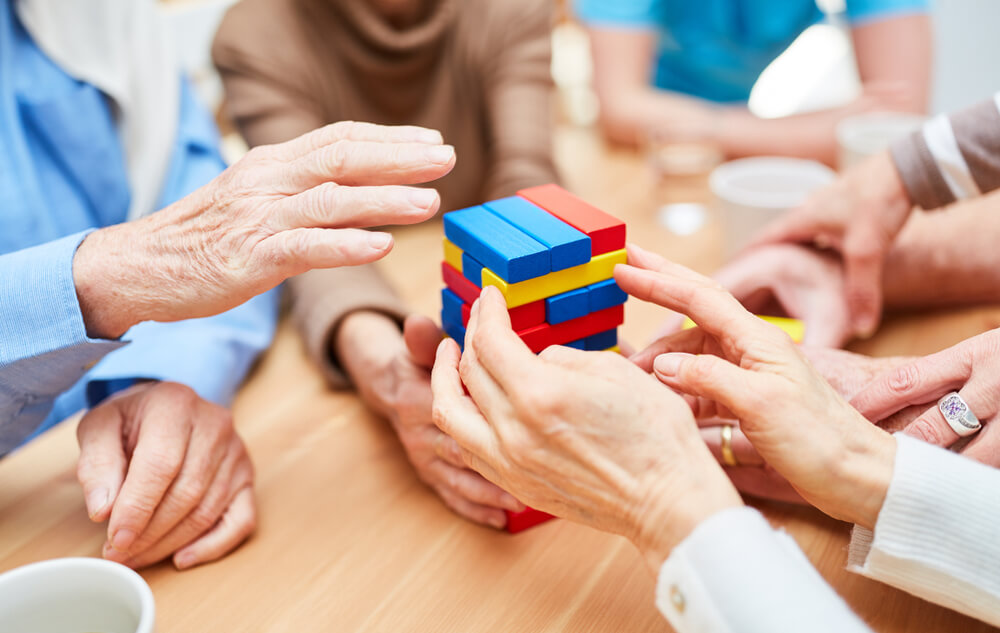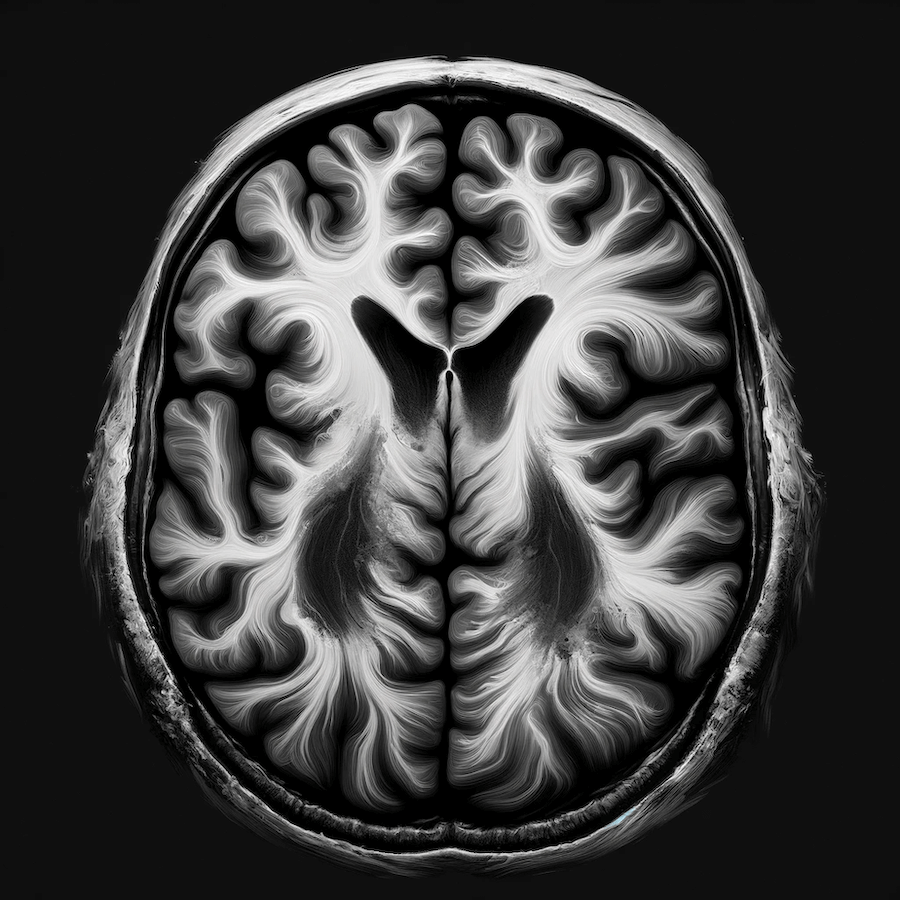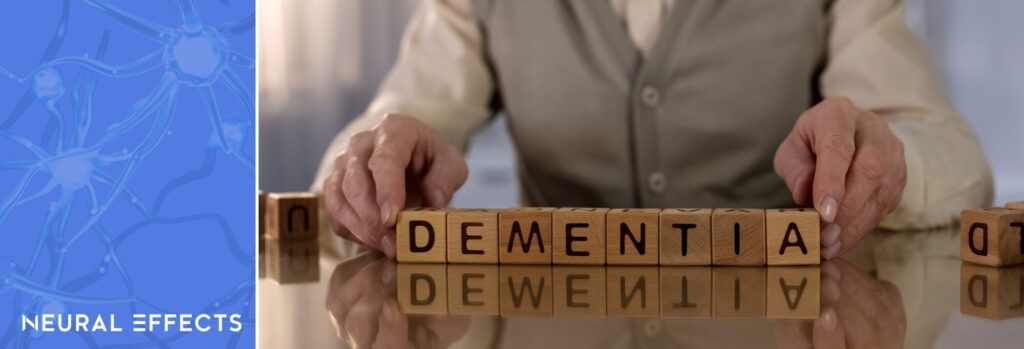Rehabilitation programs are widely recognized as a way to maximize independence in patients with dementia. These programs can help patients achieve their personal goals, delay cognitive decline, and even delay the need to move into residential care. Crucially, rehab programs can be adjusted to meet the changing needs of dementia patients as they age.
In this article, we will review the types of physical, cognitive, and psychological rehabilitation interventions available today. In most cases, patients need a combination of different services to form a holistic care plan.
At Neural Effects, we offer our patients in Provo, Utah and the surrounding valley area…
- A thorough evaluation and a comprehensive dementia care plan that they can take to each provider they choose
- Cognitive stimulation therapy & physical exercise supervised by experts
Our treatment program involves a combination of therapy and exercise to help slow down the progression of the disease and promote independent living for as long as possible. We can advise and help patients coordinate additional care so that they receive the treatment they need.
Neural Effects uses the latest evidence-based techniques to diagnose and help dementia patients. We are located in Provo, Utah and serve anyone in the Salt Lake City or the Utah County area. We are in network for most types of medical insurance. Schedule your evaluation today.
Is Rehab the Same as Therapy for Patients with Dementia?

The terms “therapy” and “rehabilitation” are often used interchangeably, but they actually mean slightly different things.
In simple terms, therapy aims to improve or restore specific abilities and functions. For example, physical therapy helps with balance and fitness, while cognitive therapy helps with memory, concentration, and other cognitive skills.
In contrast, rehabilitation (often shortened to rehab) has a wider definition. Rehabilitation refers to the entire process of helping dementia patients regain their abilities, remain proficient with activities of daily living (ADLs), and maintain independence for longer. As such, rehabilitation includes therapy and prescription drugs, as well as a broad range of other services and interventions available to dementia patients to help them function at home. For these patients, rehabilitation includes physical, cognitive, and psychological/emotional components.
Often, older adults have medical issues which may be confused for dementia due to symptom overlap or which make any existing dementia symptoms more severe. Common problems include diabetes, hypertension, heart problems, anemia, and osteoporosis. Correctly identifying and managing these conditions is crucial for the patient’s well-being. This is also part of the rehabilitation process.
Rehabilitation programs need to be customized to cover each patient’s needs and goals, acknowledging that patients have their own unique experiences, motivations, and requirements, while also taking into account what types of dementia they may have (such as Alzheimer’s, Lewy body, or vascular dementia). However, in general terms, rehab for patients with dementia patients:
- Slows the progression of symptoms
- Maintains their ability to perform Activities of Daily Life (ADLs)
- Restores or compensates for lost abilities
- Allows for independent living for longer
- Improves quality of life and well-being
- Decreases burden on carers
Physical Rehabilitation

Growing evidence supports the use of physical rehabilitation programs to help dementia patients maintain (or even improve) their physical fitness. One of the most common issues is problems with balance and posture, which inevitably lead to a high risk of falls and bone fractures. Patients may also experience stiff and weak muscles, difficulties standing up, and tremors.
Physical Therapy
Physical rehabilitation and training programs for dementia patients typically include aerobic exercises, resistance training, balance, and flexibility training, depending on what problems the patient is experiencing.
For example, for patients with gait and posture issues, physical therapists may recommend exercises to improve mobility, flexibility, and coordination, including sitting down and standing up from a chair, walking at different speeds, and dealing with obstacles in the way. Seated exercises are another popular way of providing physical activity, focusing particularly on stretching and flexibility exercises.
Physical therapy has many benefits for patients with dementia, including:
- Physical benefits: Exercise improves cardiovascular health, increases fitness and strength, and decreases the risk of falls.
- Cognitive benefits: Exercise slows down loss of cognitive function and promotes better sleep.
- Emotional benefits: Exercise improves mood and helps with mental health problems, such as anxiety and depression.
- Social benefits: Exercise reduces social anxiety, helps build stronger social connections, and supports patients’ efforts to maintain their independence for longer. Patients can carry out their daily activities more easily and enjoy improved quality of life.
Further reading: Physical therapy for dementia
Safety Modifications & Adaptations to Routines
Physical therapy is just one part of the patient’s rehabilitation. Patients also need strategies to improve safety in their environment to reduce the risk of falls, which may include safety modifications at home, for example. This is typically done with the help of an occupational therapist who specializes in geriatric care.
Further reading: Occupational therapy for dementia
These modifications involve all kinds of adaptations that are intended to increase the safety, security, and independence of dementia patients. These may include the use of medical equipment, major renovations, or simple modifications at home. The aim is to delay the need for long-term care by supporting the patient at home.
Studies show that environmental modifications can help patients perform their daily activities and improve their quality of life. It’s important that occupational therapists work with patients and their caregivers to decide what changes to make to support the patients’ functional abilities.
Suggestions for home modifications include:
- Making sure there is good lighting throughout the home. Changes in levels of light can be disorienting for dementia patients. Create an even level of lighting throughout the house by adding extra lights in entries, landings, areas between rooms, stairways, and bathrooms. Install night lights in hallways, bedrooms, and bathrooms.
- Removing anything that may be a trip hazard. This may include rugs, loose cables, or excessive clutter.
- Securing large furniture. Ensure bookshelves or wardrobes are secured to the wall to prevent tipping if patients need to hold on to them.
- Avoiding injuries in the bathroom by installing grab bars in the shower or providing additional support where needed.
Lifestyle Recommendations
The final element in physical rehabilitation involves lifestyle changes. Engaging in regular physical exercise is recommended for patients with dementia, as it improves physical health, reduces frailty, decreases the risk of depression, and improves cognitive function and mood. Crucially, exercise helps patients maintain their independence for longer, enhances the quality of life for patients and their caregivers, and reduces time spent in the hospital.
Cognitive Rehabilitation

The second part of a rehabilitation program may include cognitive treatments. Dementia includes deficits in cognitive skills, such as memory, thinking, learning, and reasoning, making it more difficult for patients to perform everyday activities and engage in social life. Patients often struggle to follow a conversation, get confused about time and place, and have trouble performing complex tasks. As a result, cognitive impairments have a major impact on the patient’s quality of life.
Growing evidence shows that cognitive rehabilitation services can help patients live as independently as they wish, engage in different activities, and maintain a sense of identity. In general terms, cognitive rehabilitation programs involve working with patients to achieve the goals that are important to them.
Potential targets for rehabilitation include everyday activities, such as shopping or self-care, language and communication, and social interactions. For example, a patient in the early stages of dementia may want to learn to use email to keep in contact with friends or be able to cook a meal without getting distracted, while for patients with more advanced symptoms, the aim may be to maintain the ability to wash and dress themselves or participate in social interactions with friends and family. Patients may undergo cognitive rehabilitation sessions at different stages of the disease to address their changing needs.
Cognitive Therapy
Cognitive rehabilitation programs for dementia typically include three types of cognitive therapy:
- Cognitive rehabilitation (While the term can be confusing, it’s not the same as a cognitive rehabilitation program.)
- Cognitive training
- Cognitive stimulation
Cognitive rehabilitation addresses the impact of cognitive decline on everyday activities and helps patients learn ways to carry out their ADLs. In practical terms, healthcare professionals speak with patients about their goals associated with their day-to-day activities and then develop ways to achieve those goals. Techniques used may include modifications at home, compensatory strategies, and memory aids. Multiple studies have shown that cognitive rehabilitation therapy can improve the way dementia patients carry out their daily activities.
Cognitive training involves the repeated practice of a set of tasks intended to improve or maintain a particular cognitive function. The idea is that repetition can help patients enhance or maintain cognitive function. Cognitive training has shown promising results in patients with mild cognitive impairment or dementia in terms of memory and attention, and it also helps control symptoms of depression and anxiety. For example, patients might repeat these memory exercises for dementia to combat memory loss.
Cognitive stimulation is a more general approach to stimulating cognitive skills. Sessions include various activities, such as discussing current news, listening to music, or playing word games. The sessions are designed to be relaxed and fun to create opportunities for people to learn, express their views, and interact with others. Of all types of cognitive therapy, cognitive stimulation has the most reliable evidence to support it. Multiple studies show that this therapy can enhance memory and thinking skills in older adults with mild to moderate dementia, which leads to improved quality of life. This is the type of cognitive therapy we offer at Neural Effects (more on this later).
Further reading: Cognitive stimulation therapy
Pharmacological Options
The second element of cognitive rehabilitation programs involves pharmacological options. In the U.S., there are currently five medications approved to treat dementia symptoms: donepezil, rivastigmine, galantamine, memantine, and aducanumab.
Donepezil, rivastigmine, and galantamine are collectively called cholinesterase inhibitors. In simple terms, they boost the levels of a chemical in the brain called acetylcholine, which helps brain cells communicate with each other. As the disease progresses, the drugs will have less effect. When this happens, the patient’s symptoms will start to get worse again.
Memantine works in a different way. Patients with dementia start accumulating excessive amounts of a chemical called glutamate in the brain. Too much glutamate damages nerve cells and makes it harder for them to send messages. Memantine blocks its action and protects brain cells.
The final option is aducanumab. This drug was recently approved as a treatment for Alzheimer’s disease by the U.S. Food and Drug Administration (FDA). Aducanumab is the first drug used to remove beta-amyloid, one of the hallmarks of Alzheimer’s disease, but studies identified potential serious side effects, including brain bleeds and seizures. For this reason, several major health systems have decided not to offer the drug to their patients, and even Medicare is severely restricting its coverage.
Lifestyle Recommendations
Finally, these programs also include recommendations for lifestyle changes to encourage patients to stay mentally and socially active. Mentally challenging activities, such as learning to play a musical instrument or playing board games with family and friends, have short-term and long-term benefits for dementia patients. It’s important to pick activities that are challenging and expose patients to new topics.
Examples of activities include:
- Arts and crafts (especially in groups)
- Playing a musical instrument or singing
- Volunteering at a local charity
- Doing brainteasers, such as puzzles, crosswords, or quizzes
- Playing card games, chess, or board games
- Reading books
- Creative writing or keeping a diary
- Learning a new language
- Brain games (available as apps for your phone or tablet)
Ideally, these activities should also include a social component. Participating in social interactions promotes cognitive skills and reduces the risk of depression. Social interactions can take many forms, from joining a local walking club to going out with friends on a regular basis.
Psychological Rehabilitation

In addition to cognitive decline, patients with dementia may also experience neuropsychiatric symptoms, including delusions, hallucinations, aggression, and repetitive movements. They might suffer from depression, anxiety, irritability, and mood changes. In medical terms, these signs are known as behavioral and psychological symptoms of dementia (BPSDs).
Patients need a thorough medical examination to determine the best treatment plan. Assessing the severity of symptoms such as aggression or delusions is key, especially for patients who are in danger of hurting themselves or others.
Non-Pharmacological Treatments
Non-pharmacological interventions can be divided into direct methods targeting the patient and indirect methods targeting their environment.
Direct interventions address the needs of the patient and include different therapies, such as sensory stimulation therapy, aromatherapy, massage, light therapy, talking therapies, validation therapy, animal-assisted therapy, garden activities, arts and crafts, music and dance sessions. Patients can also be helped with lifestyle modifications, such as through nutritional advice and exercise programs.
In many cases, these approaches are more effective than pharmacological treatments, don’t have any side effects, and are more cost-effective than pharmacological options to treat patients with dementia. In addition, these interventions reduce depressive symptoms, help control the patient’s behavior, and improve their quality of life.
Further reading: Dementia interventions

Indirect interventions involved adjusting the patient’s environment, such as controlling room temperature, light and noise levels, or educating caregivers to reduce the stress and burden placed on them. For example, a study showed that the simple act of unlocking the doors to a common area resulted in less agitated patients living in a care facility, and having access to a garden or a sensory room made patients happier.
Suggestions may include:
- Reducing noise levels, such as avoiding television or radio at high volume.
- Setting a comfortable ambient temperature throughout the house.
- Using labels and memory aids for objects the patient frequently uses.
- Ensuring easy access to the toilet.
- Having a prominent clock, calendar, and daily schedule to improve orientation.
- Making the patient’s surroundings feel like home with personal belongings and family photos if they live in a nursing home, memory care unit, or other residential care facility.
- Keeping the routine consistent as much as possible. Even if patients can’t remember everything, a routine will make them feel familiar and comfortable.
Pharmacological Treatments
Pharmacological interventions involve using a variety of different prescription drugs, including antidepressants, antipsychotics, and sleeping pills to treat common dementia symptoms. The problem is that many of these medications are used off-label because there isn’t enough data to support their use in patients with dementia, and their prescription is based on the personal opinions of physicians.
These medications for dementia patients should be:
- Prescribed for symptoms for which there is evidence of effectiveness. They should never be used to sedate patients who are difficult to manage.
- Only considered once all non-pharmacological interventions have been tried and failed or if the patient is very severely distressed.
- Used in combination with non-pharmacological interventions, as much as possible.
- Used on a short-term basis.
- Reviewed and adjusted (if needed) regularly.
For instance, agitation can be treated with a variety of antipsychotics, antidepressants, anticonvulsants, and even antihistaminic drugs, but their efficacy is often questionable. For example, the meta-analysis in this systematic review shows that antidepressants citalopram and sertraline can be useful in reducing symptoms in some patients, but antipsychotic haloperidol is not effective. In addition, some of these drugs can cause serious side effects for the patients. A recent review found so many adverse effects after using valproate (an anticonvulsant used as a mood stabilizer) that the authors advise against its use in dementia patients. Antidepressants such as paroxetine and tricyclic antidepressants should also be avoided.
Patients experiencing psychotic symptoms, such as hallucinations and delusions, may need prescription drugs to deal with these symptoms, especially if they’re likely to act on their delusions and put themselves or others at risk. Antipsychotics, such as olanzapine and risperidone, can help some patients, but these drugs are typically only used as a last resort for patients with severe symptoms. The advice from the American Psychiatric Association is to start an antipsychotic at a low dose and increase gradually if the patient tolerates it. In addition, medications should be prescribed for a short-term treatment plan and tapered after a few months. Crucially, a study found that stopping the medication at this stage does not cause symptoms to reappear, as most behavioral complications of dementia are intermittent and often do not persist for longer than three months.
Another common psychiatric symptom in dementia patients is apathy, with patients lacking motivation and initiative to do anything. The worry is that apathy is associated with higher mortality rates and increased burden for caregivers. The problem is that using cholinesterase inhibitors, memantine, antidepressants, antipsychotics, psychostimulants, and other drugs produces poor results in treating apathy. So far, no pharmacological treatment currently exists to treat this symptom in dementia patients.
Depression is inextricably linked to dementia patients, but treating this condition can be challenging. While acetylcholinesterase inhibitors and memantine can treat some symptoms of dementia, current evidence suggests that they have limited efficacy in the treatment of depressive symptoms. Studies looking at using antidepressants to treat dementia patients found similar results, so options are limited.
Dementia patients frequently experience sleep disturbances, which aggravate cognitive decline, increase the risk of falling, lower quality of life, and increase the burden on the caregiver. In addition, these problems cause drowsiness during the day, making it harder for patients to carry out their normal daily activities, such as going out or driving. It’s impossible to propose a universal method to treat sleep disorders because the symptoms vary greatly from patient to patient. Popular drugs for sleep disturbances in dementia include trazodone, benzodiazepines, Z-drugs (zolpidem, zopiclone, and zaleplon), and more recently, ramelteon, but a recent review found no evidence to suggest that pharmacological options can help dementia patients overcome their sleep problems.
Rehabilitation at Neural Effects

If you are looking for a rehabilitation program for yourself or a loved one, you may want to consider the treatment we offer at Neural Effects. Our method — called EMPOWER — combines cognitive stimulation therapy (CST) and aerobic exercise to boost the effect of therapy and help delay the progression of symptoms.
Before treatment starts, patients must complete a dementia evaluation. This includes a neurophysiology exam (also called a neurocognitive evaluation) to find out exactly how dementia has affected their brain. Our team checks the patient’s physical, cognitive, and emotional abilities. This exam takes 2–2.5 hours to complete.
Even if you already have a dementia diagnosis, you still need to complete this exam because it provides us with useful information to guide treatment decisions. If you don’t have a diagnosis yet, we coordinate with your neurologist to investigate whether you have dementia and, if so, what type.
All information gathered during this initial exam is used to create a cognitive care plan (CCP). All of our patients get a personalized CCP, even if they decide not to continue treatment with us. The CCP includes important recommendations that can help protect your cognitive health in the future.
The CCP includes the following health information:
- Diagnosis
- Results from the assessment
- Risk factors for progression and discussion of how the disease is likely to progress
- Lifestyle changes that may help the patient
- Suggestions for family involvement
- Recommended treatment options
Once this exam is completed, patients can start their therapy sessions.
Our program includes two sessions per week for seven weeks, for a total of 14 one-hour sessions.
Each session starts with a 10–15 minute session of aerobic exercise, usually done on a stationary bike or treadmill. Our therapists can adapt the exercises in intensity and duration to ensure patients stay safe. We start our therapy sessions this way because physical exercise stimulates the flow of blood in the brain. It also promotes the release of a helpful neurochemical cascade, including one called brain-derived neurotrophic factor (BDNF). BDNF makes the brain more receptive to therapy and improves cognition.
After exercise, patients engage in various activities to stimulate thinking and memory, including discussing past and present events, word games, puzzles, music, and practical activities. Two trained facilitators work with a small group of up to six patients. These facilitators guide the discussions and help patients socialize with each other.
We always invite family members and caretakers to attend the first session to learn more about the treatment. They can then support patients at home by repeating some of the activities and games.
Our staff also educate loved ones about lifestyle changes that can help dementia patients, including eating a balanced diet, engaging in regular exercise, and maintaining an active social life. Finally, families of dementia patients receive follow-up resources, including suggestions for support groups in their area for patients and their caregivers.
Neural Effects uses the latest evidence-based techniques to diagnose and help dementia patients. We are located in Provo, Utah and serve anyone in the Salt Lake City or the Utah County area. We are in network for most types of medical insurance. Schedule your evaluation today.
